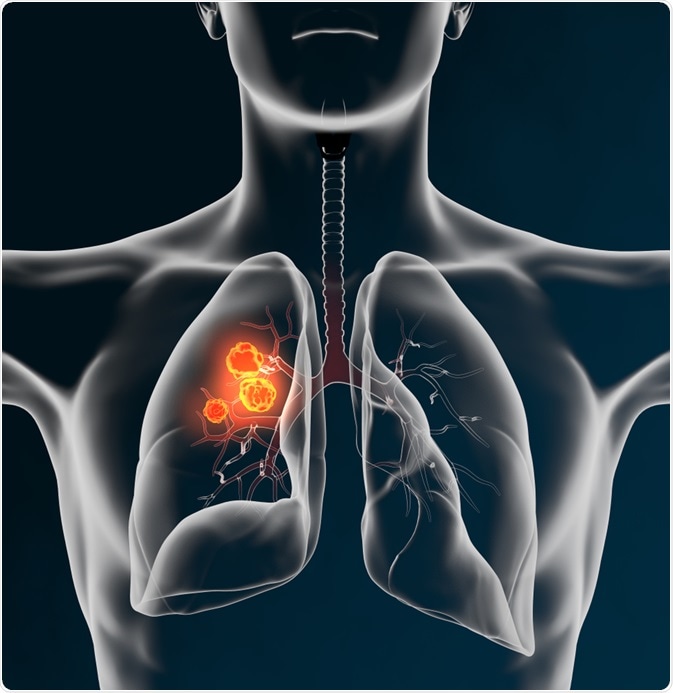Lung cancer is a serious type of cancer that is the third most common cancer to affect Americans each year. Lung cancer can originate in the trachea (windpipe), the bronchus (the main airway), or the tissue of the lung.

Image Credit: Axel_Kock / Shutterstock.com
Treatment options
The treatment for lung cancer depends on the type, size, and location of the cancer.
The treatment for non-small cell lung cancer, for example, is different from that used to treat small cell lung cancer. Small cell lung cancer is generally treated with chemotherapy because it has usually spread beyond the lung by the time it is diagnosed and therefore cannot be treated by removing a part or all of the lung. People with small cell lung cancer may also be treated with radiotherapy.
Non-small cell lung cancer, comparatively, may be treated with surgery, chemotherapy, radiotherapy, or a combination of these, depending on the stage of cancer at diagnosis.
Radiotherapy
Depending on the stage and type of cancer, radiotherapy may be used. For example, radiotherapy might be prescribed as an added measure after surgery to destroy any cancer cells that may remain and lower the risk of the cancer recurring. Prior to surgery, radiotherapy may also be used in order to shrink the cancer and make surgery safer and easier.
Radiotherapy can also be used as the main treatment for individuals where the cancer is only present in the chest but cannot be surgically removed. Additionally, in cases where people have other health problems that prevent surgery from being an option, radiotherapy can be employed. Radiotherapy is often also used to treat recurring cancer, or as a palliative treatment to decrease pain and improve the patient's quality of life.
Some of the main types of radiotherapy that are used in the treatment of lung cancer include stereotactic body radiotherapy (SBRT), intensity modulated radiotherapy (IMRT), and brachytherapy.
SBRT
SBRT is a form of external radiotherapy where intense doses of radiation are precisely delivered to the affected tissue. This procedure minimizes the amount of radiation that reaches nearby healthy tissue and reduces side effects. An X-ray or computed tomography (CT) scan may be used to locate the exact location that needs to be targeted by the therapy.
IMRT
IMRT is a computer-guided technique that is used to precisely target cancer cells. As a result, IMRT can significantly reduce the amount of radiation delivered to normal, healthy tissue, thereby reducing side effects. An X-ray or CT scan may be used to locate the exact location that needs to be targeted by the therapy.
Brachytherapy
Brachytherapy is internal radiation therapy. During this type of radiation treatment, tiny radioactive seeds are placed close to the site of cancer. Some patients may receive a specific type of brachytherapy called endobronchial brachytherapy, where high doses of radiation are delivered to the airways, which minimizes unwanted exposure to surrounding normal tissues.
Living with Lung Cancer - Radiotherapy
Chemotherapy
Chemotherapy is an important therapy in small cell lung cancer that uses drugs to attack cancer cells by disrupting the cancer’s growth. Small cell lung cancer often responds well to this form of therapy.
Cancerous cells divide in an abnormal manner that is no longer controlled as it is in healthy cells. When a healthy cell comes into contact with other similar cells, they stop dividing through the use of a mechanism referred to as contact inhibition.
Cancerous cells, on the other hand, lose this ability, thus causing cell division to no longer be limited. Whether cells are cancerous or healthy, this process of cell division occurs through the cell cycle, which begins with the resting phase and moves through active growing phases and then to division or mitosis.
Living with Lung Cancer - Chemotherapy
The success of chemotherapy at destroying cancer cells depends on how effective it is at halting cell division. The drugs usually work by damaging the DNA or RNA that instruct a cell to copy itself in the division. Cells that cannot divide will subsequently die. The faster cells are dividing, the more effective chemotherapy is likely to be, which will ultimately lead to shrinkage of the tumor.
Chemotherapy may be delivered intravenously or orally using tablets. It may be given in cycles, with treatment being received for a period of a few days, which is then followed by a rest period. Chemotherapy drugs that only affect cells when they are dividing are referred to as cell-cycle specific, whereas drugs that affect cells while they are in the rest phase are referred to as cell-cycle non-specific. Chemotherapy is therefore scheduled based on the type of cells, their division rate, and the time when a drug is likely to be effective, which is why this therapy is usually delivered in cycles.
There are many different chemotherapy drugs and drug combinations that may be used to treat patients, but most commonly, cisplatin or carboplatin is used, often in combination with a therapy called etoposide.
References
Further Reading